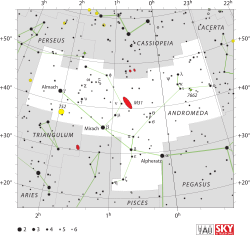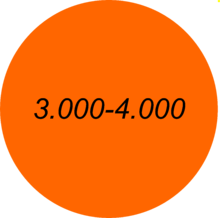Beta Andromedae

| |
| Observation data Epoch J2000.0 Equinox J2000.0 (ICRS) | |
|---|---|
| Constellation | Andromeda |
| Right ascension | 01h 09m 43.92388s[1] |
| Declination | +35° 37′ 14.0075″[1] |
| Apparent magnitude (V) | 2.05[2] (2.01 to 2.10)[3] |
| Characteristics | |
| Spectral type | M0 III[4] |
| U−B color index | +1.96[2] |
| B−V color index | +1.57[2] |
| V−R color index | 0.9[5] |
| R−I color index | +1.00[6] |
| Variable type | Semiregular[3] |
| Astrometry | |
| Radial velocity (Rv) | 0.06 ± 0.13[7] km/s |
| Proper motion (μ) | RA: 175.90[1] mas/yr Dec.: −112.20[1] mas/yr |
| Parallax (π) | 16.52 ± 0.56[1] mas |
| Distance | 197 ± 7 ly (61 ± 2 pc) |
| Absolute magnitude (MV) | –1.76[8] |
| Details | |
| Mass | 3–4[9] M☉ |
| Radius | 100[10] R☉ |
| Luminosity | 1,995[10] L☉ |
| Surface gravity (log g) | 1.52[11] cgs |
| Temperature | 3,842[11] K |
| Metallicity [Fe/H] | –0.05[11] dex |
| Rotational velocity (v sin i) | 7.2[10] km/s |
| Other designations | |
| Database references | |
| SIMBAD | data |
Beta Andromedae (β Andromedae, abbreviated Beta And, β And), also named Mirach,[13] is a prominent star in the northern constellation of Andromeda. It is located northeast of the Great Square of Pegasus and is theoretically visible to all observers north of 54° S. It is commonly used by stargazers to find the Andromeda Galaxy. The galaxy NGC 404, also known as Mirach's Ghost, is visible seven arc-minutes away.[14]
This star has an average apparent visual magnitude of 2.05,[2] which makes it the brightest star in the constellation. However, the luminosity varies slightly from magnitude +2.01 to +2.10.[3] Based upon parallax measurements, it is located at a distance of roughly 197 light-years (60 parsecs) from the Sun.[1] The apparent magnitude of this star is reduced by 0.06 from extinction caused by the gas and dust along the line of sight.[7]
Properties

Beta Andromedae is a red giant with a stellar classification of M0 III.[4] Since 1943, the spectrum of this star has served as one of the stable anchor points by which other stars are classified.[15] It is suspected of being a semiregular variable star whose apparent visual magnitude varies from +2.01 to +2.10.[3] At this stage of the star's evolution, the outer envelope has expanded to around 100 times the size of the Sun.[10] It is radiating 1995[10] times the luminosity of the Sun at an effective temperature of 3842 K.[11]
Nomenclature
- Beta Andromedae is the star's Bayer designation.
- It had the traditional name of Mirach, and its variations, such as Mirac, Mirar, Mirath, Mirak, etc. (the name is spelled Merach in Burritt's The Geography of the Heavens),[16] which come from the star's description in the Alfonsine Tables of 1521 as super mizar. Here, mirat is a corruption of the Arabic ميزر mīzar "girdle", which appeared in a Latin translation of the Almagest.[12] This word refers to Mirach's position at the left hip of the princess Andromeda.[17]
- In 2016, the International Astronomical Union organized a Working Group on Star Names (WGSN)[18] to catalog and standardize proper names for stars. The WGSN's first bulletin of July 2016[19] included a table of the first two batches of names approved by the WGSN; which included Mirach for this star.
- Medieval astronomers writing in Arabic called β Andromedae Janb al-Musalsalah (English: The Side of the Chained (Lady)); it was part of the 26th manzil (Arabian lunar mansion) Baṭn al-Ḥūt, the Belly of the Fish, or Qalb al-Ḥūt, the Heart of the Fish.[12][20] The star has also been called Cingulum and Ventrale.[12] This al-Ḥūt was an indigenous Arabic constellation, not the Western "Northern Fish" part of the constellation Pisces.[20] These names are not from the Arabic marāqq, loins, because it was never called al-Marāqq in Arabian astronomy.[20] Al Rishā', the Cord (of the well-bucket), on al-Sūfī's star map. It is origin of the proper name Alrescha for Alpha Piscium.[12][21][22]
- In Chinese, 奎宿 (Kuí Sù), meaning Legs (asterism), refers to an asterism consisting of β Andromedae, η Andromedae, 65 Piscium, ζ Andromedae, ε Andromedae, δ Andromedae, π Andromedae, ν Andromedae, μ Andromedae, σ Piscium, τ Piscium, 91 Piscium, υ Piscium, φ Piscium, χ Piscium and ψ¹ Piscium. Consequently, β Andromedae itself is known as 奎宿九 (Kuí Sù jiǔ, English: the Ninth Star of Legs.)[23]
- The people of Micronesia named this star as Kyyw "The Porpoise", and become once of Micronesian month name.[24]
- Mirach is listed in MUL.APIN as KA.MUSH.I.KU.E, meaning "the Deleter" (the alternative star is α Cas).[25]
References
- 1 2 3 4 5 6 van Leeuwen, F. (November 2007), "Validation of the new Hipparcos reduction", Astronomy and Astrophysics, 474 (2): 653–664, arXiv:0708.1752
 , Bibcode:2007A&A...474..653V, doi:10.1051/0004-6361:20078357
, Bibcode:2007A&A...474..653V, doi:10.1051/0004-6361:20078357 - 1 2 3 4 Johnson, H. L.; et al. (1966), "UBVRIJKL photometry of the bright stars", Communications of the Lunar and Planetary Laboratory, 4 (99), Bibcode:1966CoLPL...4...99J
- 1 2 3 4 NSV 414, database entry, table of suspected variable stars, Combined General Catalog of Variable Stars (GCVS4.2, 2004 Ed.), N. N. Samus, O. V. Durlevich, et al., CDS ID II/250.
- 1 2 Morgan, W. W.; Keenan, P. C. (1973), "Spectral Classification", Annual Review of Astronomy and Astrophysics, 11 (1): 29, Bibcode:1973ARA&A..11...29M, doi:10.1146/annurev.aa.11.090173.000333
- 1 2 NAME MIRACH -- Variable Star, database entry, SIMBAD. Accessed on line August 12, 2008.
- ↑ HR 337, database entry, The Bright Star Catalogue, 5th Revised Ed. (Preliminary Version), D. Hoffleit and W. H. Warren, Jr., CDS ID V/50. Accessed on line August 12, 2008.
- 1 2 Famaey, B.; et al. (January 2005), "Local kinematics of K and M giants from CORAVEL/Hipparcos/Tycho-2 data. Revisiting the concept of superclusters", Astronomy and Astrophysics, 430 (1): 165–186, arXiv:astro-ph/0409579
 , Bibcode:2005A&A...430..165F, doi:10.1051/0004-6361:20041272
, Bibcode:2005A&A...430..165F, doi:10.1051/0004-6361:20041272 - ↑ Elgarøy, Øystein; Engvold, Oddbjørn; Lund, Niels (March 1999), "The Wilson-Bappu effect of the MgII K line - dependence on stellar temperature, activity and metallicity", Astronomy and Astrophysics, 343: 222–228, Bibcode:1999A&A...343..222E
- ↑ Mirach Archived December 16, 2008, at the Wayback Machine., Stars, Jim Kaler. Accessed on line August 13, 2008.
- 1 2 3 4 5 Massarotti, Alessandro; et al. (January 2008), "Rotational and Radial Velocities for a Sample of 761 HIPPARCOS Giants and the Role of Binarity", The Astronomical Journal, 135 (1): 209–231, Bibcode:2008AJ....135..209M, doi:10.1088/0004-6256/135/1/209
- 1 2 3 4 Soubiran, C.; et al. (2008), "Vertical distribution of Galactic disk stars. IV. AMR and AVR from clump giants", Astronomy and Astrophysics, 480 (1): 91–101, arXiv:0712.1370
 , Bibcode:2008A&A...480...91S, doi:10.1051/0004-6361:20078788
, Bibcode:2008A&A...480...91S, doi:10.1051/0004-6361:20078788 - 1 2 3 4 5 Allen, R. A. (1899), Star-names and Their Meanings, p. 36
- ↑ "IAU Catalog of Star Names". Retrieved 28 July 2016.
- ↑ Darling, David, "Mirach's Ghost (NGC 404)", The Internet Encyclopedia of Science, retrieved 2008-08-15
- ↑ Garrison, R. F. (December 1993), "Anchor Points for the MK System of Spectral Classification", Bulletin of the American Astronomical Society, 25: 1319, Bibcode:1993AAS...183.1710G, retrieved 2012-02-04
- ↑ p. 18, The Geography of the Heavens, Elijah Hinsdale Burritt, Hiram Mattison, and Henry Whitall, New York: Sheldon & Company, 1856.
- ↑ Mirach, MSN Encarta. Accessed on line August 19, 2008. Archived 2009-10-31.
- ↑ "IAU Working Group on Star Names (WGSN)". Retrieved 22 May 2016.
- ↑ "Bulletin of the IAU Working Group on Star Names, No. 1" (PDF). Retrieved 28 July 2016.
- 1 2 3 George A.Davis Jr. (1971) Selected List of Star Names, p. 5.
- ↑ ibid. p. 19.
- ↑ Kunitsch, Paul; Smart, Tim (2006). A Dictionary of Modern Star names: A Short Guide to 254 Star Names and Their Derivations. Cambridge, Massachusetts: Sky Publishing Corp. p. 50. ISBN 978-1-931559-44-7.
- ↑ (Chinese) AEEA (Activities of Exhibition and Education in Astronomy) 天文教育資訊網 2006 年 5 月 19 日
- ↑ p. 345, Exploring Ancient Skies: A Survey of Ancient and Cultural Astronomy, David H. Kelley, Eugene F. Milone, Anthony F. (FRW) Aveni, Berlin, Springer, 2011.
- ↑ Rogers, J. H. (February 1998). "Origins of the ancient constellations: I. The Mesopotamian traditions". Journal of the British Astronomical Association, no.1. 108: 9–28. Bibcode:1998JBAA..108....9R.
Further reading
- Davis Jr., G. A., (1971) Pronunciations, Derivations, and Meanings of a Selected List of Star Names, (rep.) Cambridge, Sky Publishing Corp.
- Kunitzsch, P., (1959) Arabische Sternnamen in Europa
- Kunitzsch. P., (ed.) (1990) Der Sternkatalog des Almagest, Band II
External links
- Image MIRACH
- Beta Andromedae on WikiSky: DSS2, SDSS, GALEX, IRAS, Hydrogen α, X-Ray, Astrophoto, Sky Map, Articles and images
Coordinates: ![]() 01h 09m 43.9236s, +35° 37′ 14.008″
01h 09m 43.9236s, +35° 37′ 14.008″